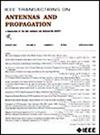Sidelobe Levels of Intermodulation Distortion Due to Element Pattern Variations in Phased Array Receivers
IF 4.6
1区 计算机科学
Q1 ENGINEERING, ELECTRICAL & ELECTRONIC
引用次数: 0
Abstract
This article develops the theory to predict the sidelobe levels (SLLs) of intermodulation distortion in phased array receivers and validates the theory with Monte Carlo simulations and over-the-air measurements. It has previously been established in the literature that when intermodulation distortion is generated by signals incident on a phased array, the intermodulation distortion signal component has a linear phase relationship across the elements in the array such that the intermodulation distortion behaves as if it has an apparent angle of arrival. It is shown in this article that the SLLs associated with the intermodulation distortion signal components are significantly higher than the SLLs of the fundamental signals as a result of the error levels increasing through the nonlinear components. This is confirmed with a measurement campaign of 14 different test scenarios, in which the average SLLs of the intermodulation distortion were 7.6 dB higher than the average SLLs of the fundamental signals. When the receiver is beam steered to a direction away from the apparent angle of the intermodulation distortion, the predicted SLL can be used to calculate an effective third-order intercept of the receiver that takes into account the anticipated spatial rejection of the beamformer. This information helps predict the system performance of a phased array receiver in the presence of nearby interfering signals and can help determine receiver linearity requirements.相控阵接收机中元件方向图变化引起的互调失真的旁瓣电平
本文提出了相控阵接收机互调失真的旁瓣电平预测理论,并通过蒙特卡罗仿真和空中测量对理论进行了验证。以前的文献已经证实,当信号入射相控阵产生互调失真时,互调失真信号分量在阵列中各元素之间具有线性相位关系,使得互调失真表现得好像具有表观到达角。本文表明,由于非线性分量的误差水平增加,与互调失真信号分量相关的sll显著高于基波信号的sll。通过对14种不同测试场景的测量活动证实了这一点,其中互调失真的平均sll比基波信号的平均sll高7.6 dB。当接收机被波束引导到远离互调失真视角的方向时,预测的SLL可用于计算接收机的有效三阶截距,该截距考虑了预期的波束形成器的空间抑制。这些信息有助于预测在附近存在干扰信号时相控阵接收机的系统性能,并有助于确定接收机的线性要求。
本文章由计算机程序翻译,如有差异,请以英文原文为准。
求助全文
约1分钟内获得全文
求助全文
来源期刊
CiteScore
10.40
自引率
28.10%
发文量
968
审稿时长
4.7 months
期刊介绍:
IEEE Transactions on Antennas and Propagation includes theoretical and experimental advances in antennas, including design and development, and in the propagation of electromagnetic waves, including scattering, diffraction, and interaction with continuous media; and applications pertaining to antennas and propagation, such as remote sensing, applied optics, and millimeter and submillimeter wave techniques

 求助内容:
求助内容: 应助结果提醒方式:
应助结果提醒方式:


